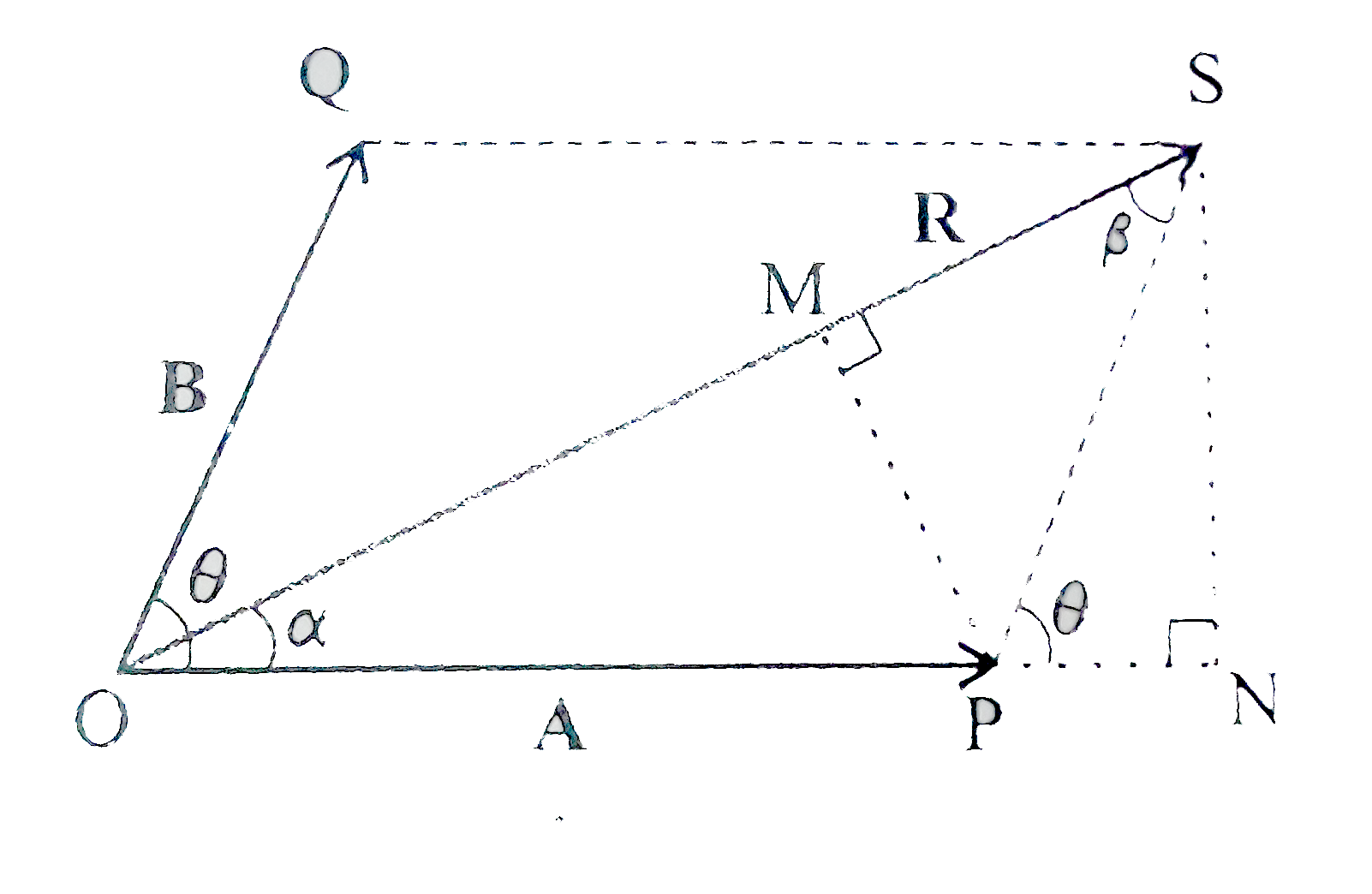The resultant of the two vectors →a and →b of magnitudes 6 and 10 respectively is at right angles to the vector →a Find their resultant and also the angle between the given vectors.
127∘
143∘
120∘
150∘
The correct Answer is:a
To solve the problem, we need to find the resultant vector →R of two vectors →a and →b with magnitudes 6 and 10 respectively, given that →R is at right angles to →a. We also need to determine the angle θ between the two vectors.
1. Understanding the Problem:
- We have two vectors →a and →b with magnitudes |→a|=6 and |→b|=10.
- The resultant vector →R is perpendicular to →a.
2. Setting Up the Vectors:
- Let →a=6^i (along the x-axis).
- Let →b make an angle θ with →a. Thus, we can express →b in terms of its components:
→b=|→b|cos(θ)^i+|→b|sin(θ)^j=10cos(θ)^i+10sin(θ)^j
3. Finding the Resultant Vector:
- The resultant vector →R is given by:
→R=→a+→b=6^i+(10cos(θ)^i+10sin(θ)^j)
- Simplifying this, we get:
→R=(6+10cos(θ))^i+10sin(θ)^j
4. Condition for Perpendicularity:
- Since →R is perpendicular to →a, the dot product →R⋅→a must equal zero:
→R⋅→a=(6+10cos(θ))⋅6+10sin(θ)⋅0=0
- This simplifies to:
6+10cos(θ)=0
- Solving for cos(θ):
10cos(θ)=−6⟹cos(θ)=−35
5. Finding θ:
- To find θ, we can use the cosine inverse function:
θ=cos−1(−35)
6. Finding the Magnitude of the Resultant:
- The magnitude of the resultant |→R| can be calculated using Pythagoras' theorem:
|→R|=√(6+10cos(θ))2+(10sin(θ))2
- Substituting cos(θ)=−35:
6+10cos(θ)=6−6=0
- Therefore, the x-component of →R is zero, and we only have the y-component:
|→R|=|10sin(θ)|
- Using sin2(θ)+cos2(θ)=1:
sin2(θ)=1−(−35)2=1−925=1625⟹sin(θ)=45
- Thus, the magnitude of →R is:
|→R|=10⋅45=8
Final Results:
- The magnitude of the resultant vector |→R|=8.
- The angle θ=cos−1(−35).
- We have two vectors →a and →b with magnitudes |→a|=6 and |→b|=10.
- The resultant vector →R is perpendicular to →a.
- Let →a=6^i (along the x-axis).
- Let →b make an angle θ with →a. Thus, we can express →b in terms of its components:
→b=|→b|cos(θ)^i+|→b|sin(θ)^j=10cos(θ)^i+10sin(θ)^j
- The resultant vector →R is given by:
→R=→a+→b=6^i+(10cos(θ)^i+10sin(θ)^j)
- Simplifying this, we get:
→R=(6+10cos(θ))^i+10sin(θ)^j
- Since →R is perpendicular to →a, the dot product →R⋅→a must equal zero:
→R⋅→a=(6+10cos(θ))⋅6+10sin(θ)⋅0=0
- This simplifies to:
6+10cos(θ)=0
- Solving for cos(θ):
10cos(θ)=−6⟹cos(θ)=−35
- To find θ, we can use the cosine inverse function:
θ=cos−1(−35)
- The magnitude of the resultant |→R| can be calculated using Pythagoras' theorem:
|→R|=√(6+10cos(θ))2+(10sin(θ))2
- Substituting cos(θ)=−35:
6+10cos(θ)=6−6=0
- Therefore, the x-component of →R is zero, and we only have the y-component:
|→R|=|10sin(θ)|
- Using sin2(θ)+cos2(θ)=1:
sin2(θ)=1−(−35)2=1−925=1625⟹sin(θ)=45
- Thus, the magnitude of →R is:
|→R|=10⋅45=8
- The magnitude of the resultant vector |→R|=8.
- The angle θ=cos−1(−35).
Similar Questions
Knowledge Check
Consider a system of two vectors
→a=3ˆI+4ˆj,→b=ˆi+ˆj ,A→r=√2→a+5→b will be making equal angles with and →a and →bBThe angle made by →r=→a+→b with →a will be smaller as compared to angle made by with →r with →bCAngle made by →r=→a+→b with be greater as compared to angle made by with →bDIncomplete information to predict any of the above optionsIf two vectors are equal and their resultant is also equal to one of them, then the angle between the two vectors is
A60∘B120∘C90∘D0∘The magnitude of the vector product of two vectors and may be : →A and →B
Agreater than ABBequal to ABCless than ABDequal to zero
Let →C=→A+→B then :
View SolutionGiven vector→A=2ˆI+3ˆj , the angle between →A and y-axis is :
View SolutionThe maqunitudes of vecotr →A,→B and →C are respectively 12,5 and 13 units and →A+→B=→C then the angle between →A and →B is :
View SolutionThe resultant of two vectors of same magnitude is equal to the magnitude of one of the vectors, then the angle between them is
View SolutionIf →A+→B+→C =0 and A = B + C, the angle between →A and →B is :
View Solution

